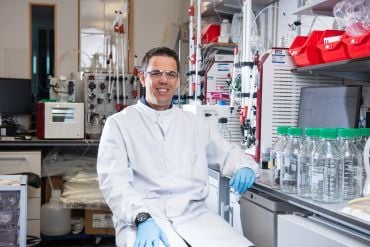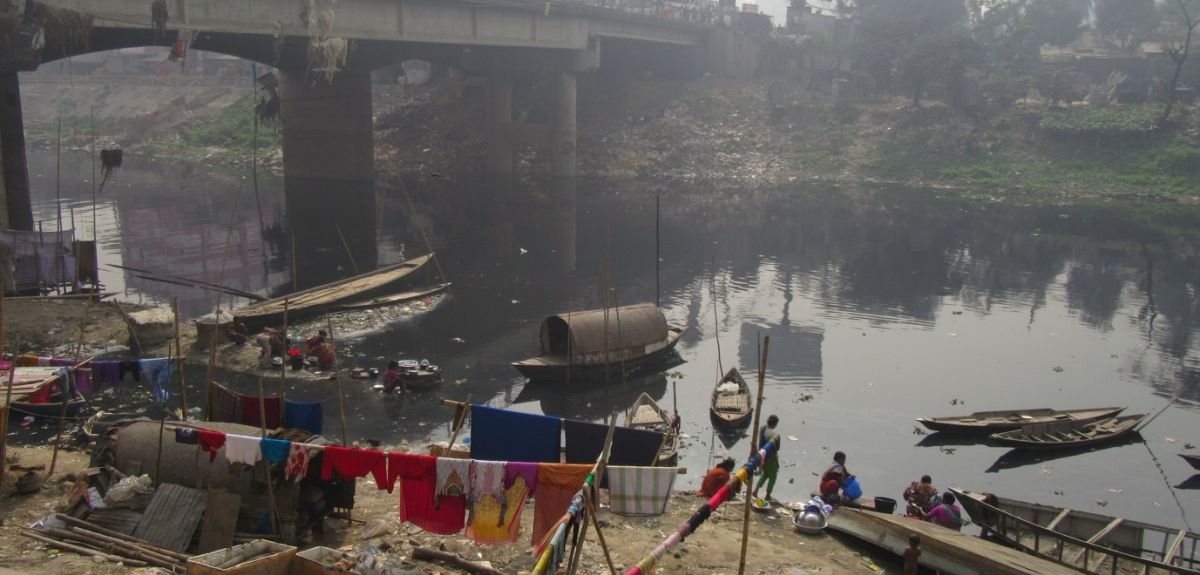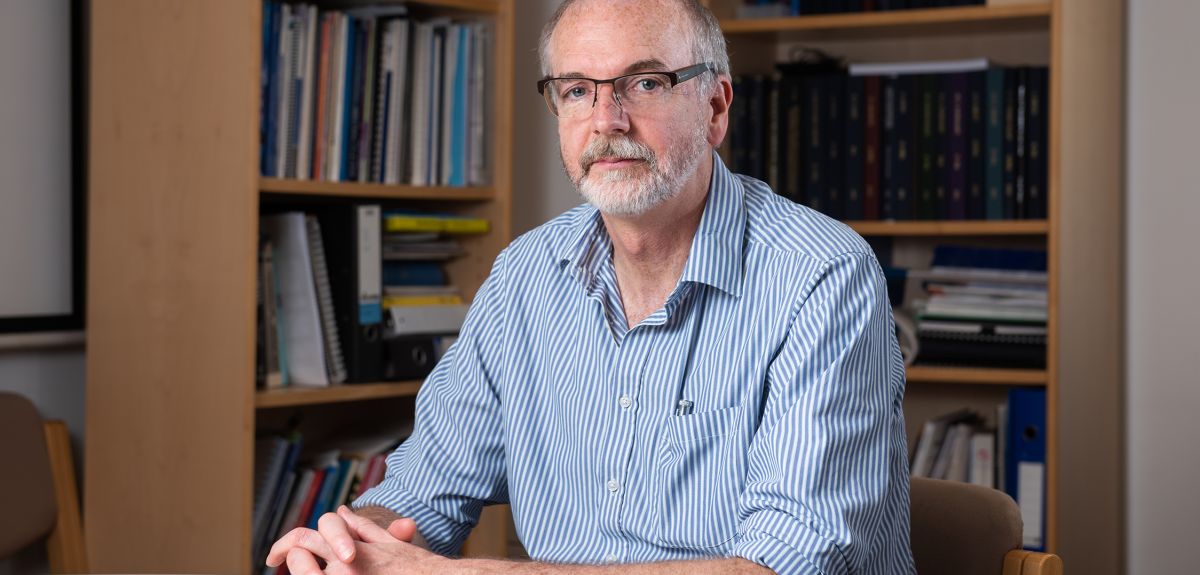Features
 Photo | Prof. Sandy Douglas in his lab
Photo | Prof. Sandy Douglas in his lab
By Dr Sandy Douglas
In April 2020, as the University was planning the first clinical trials for the COVID-19 vaccine, some began to wonder how to supply the vaccine to the world - if it worked. A rather worried colleague said to me, ‘But vaccine manufacturing is not really what we do, is it?’.
They were right in some ways: the University of Oxford is not a vaccine manufacturing company. A small group of University scientists had, however, been working on the problem for quite some time.
My team in the Jenner Institute had started research on manufacturing a few years earlier, to solve challenges around making an adenovirus-based rabies vaccine. The method we developed was designed to be very simple (so it could be done by many manufacturing facilities) and so it would work for other adenovirus-based vaccines (and might be useful for a new disease). Unfortunately, it had a major limitation: even if it were scaled-up massively, this method would not make enough vaccine to tackle a pandemic.
So, in early February 2020, it was a matter of concern that, although Oxford had the capacity to develop a COVID-19 vaccine, and clinical trials might take only a few months, manufacturing ‘at pandemic scale’ would take much longer. The technology simply was not in place.
In February 2020...although Oxford had the capacity to develop a COVID-19 vaccine...manufacturing ‘at pandemic scale’ would take much longer. The technology simply was not in place
A well-timed discovery provided a critical advance. At the start of the pandemic, a new team member, Dr Carina Joe, was the only researcher at the University working full-time on large-scale production of adenovirus vectored vaccines. In January 2020, she had found a way of creating up to 10 times more vaccine from a modified manufacturing process. She did this at a tiny scale: just 30 mL of cells (two tablespoons).
If the vaccine were going to be available quickly, this needed to be repeated on a scale at least 5,000 times greater, and before it was even known if the vaccine worked. Without ‘proof-of-concept’, that it could be made at such scale, it was unlikely any major funder or pharmaceutical company would support the vaccine programme.
We turned to the contacts book of Professor Catherine Green, Head of Clinical BioManufacturing Facility (where the first doses of the vaccine were being made for clinical trials), and started getting in touch with the handful of biotech companies in the UK and nearby who might be able to help.
The response was incredible. By late February, there was a plan for Carina’s ‘two tablespoons’ process to be tested on a large-scale ‘practice run’ at Pall Biotech’s lab in Portsmouth. Work which would normally have taken years was compressed into a few months and, if successful, would show that the vaccine could be created at ‘pandemic scale’.
A well-timed discovery provided a critical advance...a new team member, Dr Carina Joe...found a way of creating up to 10 times more vaccine from a modified manufacturing process....at a tiny scale: just 30 mL of cells (two tablespoons).
At that point, the vaccine team had not produced a single dose of clinical-grade COVID-19 vaccine. So it seemed preposterous to discuss, even in private with colleagues, if the process could produce one billion doses. Some early calculations looked encouraging, but no single manufacturing site would be able to deliver the scale needed and we were worried that governments might choose to vaccinate their populations first - meaning that low- and middle-income countries (LMICs) would be at the back of the queue.
It was clear multiple sites were needed; a model known as ‘distributed manufacturing’. And they needed to be in multiple countries, including LMICs. This approach had never been set up at this speed or scale for a brand-new vaccine, but by mid-March 2020, five manufacturers were ready to start ‘technology transfer’ work.
By late February, there was a plan for Carina’s ‘two tablespoons’ process to be tested on a large-scale ‘practice run’ ...Work which would normally have taken years was compressed into a few months
While three – Oxford Biomedica, Cobra Biologics, and Halix – would initially work on a plan to supply the UK, the others were one of the biggest LMIC biological manufacturing contractors, and the biggest LMIC vaccine manufacturer.
Soon, other companies came on board to supply equipment and materials. Jenner project manager, Dr Adam Ritchie, worked hard to ensure this group was shaped into a co-operative consortium: all sharing information, effort, and a vision of delivering a vaccine for the world as safely and quickly as possible.
On the 30 March 2020, the UK government’s newly-formed Vaccines Taskforce was in touch. Two weeks later, and before Phase I clinical trial had started, we were discussing a £65 million proposal to fund the consortium to supply tens of millions of vaccine doses to the UK. This was accepted quickly, so February’s pipe dream had become April’s reality.
In March 2020, the newly-formed Vaccines Taskforce was in touch. Two weeks later, we were discussing a £65 million proposal to fund the consortium to supply tens of millions of vaccine doses to the UK...February’s pipe dream had become April’s reality
It is well known that AstraZeneca committed to sell the product on a not-for-profit basis during the pandemic, and in perpetuity in low- and middle-income countries. It is less well known that AZ also started manufacturing, ahead of clinical trial results and including at sites in LMICs. This was at least as important as the price. An inexpensive vaccine is of no use if it is not available.
AZ has continued with both the UK-oriented manufacturing consortium and our LMIC partners, including the Serum Institute of India. Together, these have provided a large proportion of the billion doses made to date. And they have gone far beyond this, transferring our process to produce the vaccine to more than 25 partners across at least 15 countries, including additional sites in LMICs.
The effort to manufacture this vaccine has been extraordinary...It has not yet been fully appreciated how radically different...from the public perception of ‘big pharma’.
Big challenges remain, but the effort to manufacture this vaccine has been extraordinary in so many ways. It has not yet been fully appreciated how radically different it has been from the public perception of ‘big pharma’
Going ‘all out’ for maximum volume of supply from multiple sites has been a huge task, even for a company of AZ’s size, and I remain to this day delighted with the professionalism and zeal with which I see their team approaching this task.
Big challenges remain, but the effort to manufacture this vaccine has been extraordinary in so many ways. It has not yet been fully appreciated how radically different it has been from the public perception of ‘big pharma’.
Dr Sandy Douglas is a research group leader in Oxford’s Jenner Institute, who and has led the University’s contribution to the manufacturing scale-up the COVID-19 vaccine.
Urgent action is needed to protect global water security from the impacts of climate and climate change, according to a report today from Oxford’s REACH programme.
Emphasising the need for research and planning, while highlighting the unequal and complex impact of climate on water security, the report makes three key recommendations:
- More accurate and granular analysis of climate risks is needed to increase relevance of climate information.
- Metrics for monitoring climate resilience in water systems are critical to track progress and inform investments for water security.
- New institutional models that improve water security are critical for climate resilience.
Dr Katrina Charles, REACH co-director, says, ‘Climate change will increasingly affect water availability and quality, with devastating consequences for the most vulnerable. Improving water security is critical to build resilience to the changing climate.’
Climate change will increasingly affect water availability and quality, with devastating consequences for the most vulnerable. Improving water security is critical to build resilience to the changing climate
Dr Katrina Charles
According to the full report, ‘Improving water security is essential to achieve environmental protection, economic growth, poverty reduction, and improvements in public health. Water security is often presented as a technical challenge, but the decisions that define it are deeply political.
‘REACH recognises that the risks to people affected by poverty are often neither identified nor addressed. Improving water security requires managing complex and competing water-related risks in order to deliver sustainable and equitable outcomes for all.’
Working in Bangladesh, Kenya and Ethiopia, the REACH programme is led by the University of Oxford and funded by UK Aid Direct from the UK Foreign, Commonwealth & Development Office (FCDO). This report is based on six years of research developed in collaboration with research teams in these countries. UNICEF at the global, regional and country levels is a key partner supporting uptake of the research, in collaboration with national governments and their relevant ministries.
The report maintains, ‘Seasonal changes and extreme weather events have negative consequences for lives and livelihoods where water security is poor. Where populations are affected by extreme poverty and climate resilience is lacking, these impacts can be devastating.'
Seasonal changes and extreme weather events have negative consequences for lives and livelihoods where water security is poor
REACH report
According to the report, the programme’s research shows the unequal and, sometimes hidden, impact of climate change – which, the team says, can be counter-intuitive. The differing impacts across REACH’s country specific locations underpin the team’s call for further research and planning for climate and climate change.
The water insecurity of the urban poor is highlighted, with cities facing ongoing risks from pollution and urbanisation as well as increasing demand. Better management and planning is essential.
Meanwhile, the report reveals the devastating impact of climate on the lives of women, children and older people in rural settings. It calls for better analysis and communication of information – to help build better capacity, planning and resilience for potential changes in water quantity and quality.
Dr Charles maintains, ‘To build the adaptive capacity of water systems to cope with changes in climate, climate information needs to be available to water managers at the appropriate spatial and temporal scale....More investment is needed to provide the tools that water managers need to make informed decisions to increase climate resilience, such as accurate projections at local scales and seasonal forecasting based on understanding of local climate drivers.’
COVID-19 represents an unprecedented blow to cultural life; social distancing just is not compatible with full-scale live performance. Theatres, concert halls, festivals, galleries and museums have been silent. And despite a welcome government rescue package, an upcoming generation of actors, artists, comedians, dancers, designers, singers and writers often had to seek alternative forms of employment.
In the early days of the pandemic, during the first lockdown, the actress Fiona Shaw spoke of ‘culture as everything, a way of travelling, even at home’. She was speaking to mark the launch of the Boundless Creativity project, which has provided real-time intelligence and comprehensive data on the impact of the coronavirus across the UK’s arts, cultural and creative sectors.
Yet, leading figures from public and private organisations, large and small, up and down the country, say that culture has fought back and kept us going. Life in lockdown proved distinctly unsettling, like living in a science fiction movie not knowing the ending.
Life in lockdown proved distinctly unsettling, like living in a science fiction movie not knowing the ending....But it has been to culture people turned...Despite their closed doors, organisations adapted and innovated...just when we needed them most
But it has been to culture that people turned, to process what was happening and to express their emotional responses. Despite their closed doors, organisations adapted and innovated, whether to educate and entertain or to comfort and console, just when we needed them most.
Their ability to do so derived in part from the fact we have at our disposal more advanced technology than ever before. The digital world was already moving very fast before the crisis, forcing us to look at the economy of tomorrow, into which citizens will have to move. If no one knows exactly what the ‘new normal’, after Covid will look like, the UK’s cultural and creative industries are providing some tantalising glimpses, especially in the realm of augmented and mixed reality.
In the words of the Classicist, Professor Mary Beard, ‘We will look back to these dark and cloudy times as the moment when we really did harness technology to open up the best of what arts and culture have to offer on a wider and grander scale.’
The evidence we have gathered shows a marked increase in digital cultural consumption during lockdown, despite problems of unequal broadband access and digital literacy. And public research spending choices should reflect the innovative capacity of creative industries.
If no one knows what the ‘new normal’, after Covid will look like, the UK’s cultural and creative industries are providing tantalising glimpses...And public research spending choices should reflect the innovative capacity of creative industries
Twice as many under-45s have engaged in cultural activities online, compared with the over-45s. And digital technologies have turned consumers into producers via platforms such as Instagram and YouTube. But, across the entire age range, casual and marginal users have been converted into more intensive users of technology in search of satisfying digital cultural experiences.
Watching filmed performances, looking at art online, attending Zoom readings of plays, or adopting a pop star’s avatar in a video game; there has been a striking diversification of what is on offer.
Two-thirds of Britons now think it is possible to have a meaningful cultural experience online. Not all forms of cultural product have translated, however. Digital is not a substitute for live performance.
Artists have sometimes chafed at its constraints. Content needs to be adapted, or entirely rethought, for digital platforms, and online experiences work best when they have intimacy and authenticity. Yet, many of those to whom we spoke expect virtual reality and reality itself to evolve alongside each other, with performance to live audiences integrated with streaming to global ones. This hybrid future is likely to be a distinctive marker of the UK’s remarkably adaptable cultural sector.
The extraordinary demand we have witnessed in the past year for cultural products, services and experiences points to the potential for post-Covid recovery to be powered by the creative industries.
The extraordinary demand we have witnessed in the past year for cultural products, services and experiences points to the potential for post-Covid recovery to be powered by the creative industries.
Biomedical science is tackling the primary physical effects of the virus, the arts, cultural and creative sectors can help tackle its secondary social and economic effects.
The key recommendation of our report, is that in the forthcoming autumn spending review an equivalent effort be made in the domain of R&D for creative technology as is made for other digital spheres. Where creative meets ‘tech’ is the place where great cultural and material value will be derived in the next 20 years.
There is a compelling and consequential research agenda in exploring how to reach new global audiences digitally, how to broaden digital access for producers and consumers, how to overcome entry barriers to the digital market faced by freelancers and smaller creative organisations, and how to bring the benefits of cultural access and participation where they are most needed, including for those struggling with the pandemic’s effects on mental health.
Lives, as well as livelihoods, would be transformed by a major new cross-sectoral and collaborative drive for ‘science for creativity’: university researchers in the arts and humanities joining forces with the latest digital and data science, in partnership with a powerhouse of the UK’s economy.
Biomedical science is tackling the primary physical effects of the virus, the arts, cultural and creative sectors can help tackle its secondary social and economic effects
There is precedent for this, with UK Research and Innovation’s Creative Clusters and Audience of the Future programmes transforming university interactions with their cultural hinterlands and the bringing cutting-edge immersive technology into museums, theatre, animation and gaming. These programmes provide a springboard for something even more ambitious.
The pandemic has brought into sharp focus the true value of one of the UK’s crown jewels, its creative industries. If tough spending choices on R&D are around the corner, we would do well to keep that in mind.
Andrew Thompson is chair of global and imperial history at the University of Oxford and co-chair, with Oriel College Provost, Lord Neil Mendoza, of Boundless Creativity.
Boundless Creativity is sponsored by the Arts and Humanities Research Council and the Department for Culture, Media and Sport.
Professor Sir Andrew Pollard, Director of the Oxford Vaccine Group and Professor of Paediatric Infection and Immunity, takes a moment to reflect on one billion doses of the Oxford coronavirus vaccine released worldwide.
With falling Covid-19 cases all across the UK, the wild positivity in the media, and yesterday’s announcement from AstraZeneca that they have passed 1 billion doses manufactured of our Oxford vaccine, you could be forgiven this week for thinking that it is all over - but it isn’t.
The world is in the third wave of the pandemic with global case numbers of Covid-19 rising rapidly, just not here. I don’t want to sound too gloomy given the remarkable position in which we find ourselves, especially with cases falling because of growing immunity in our population from the vaccines, likely combined with Summer behavioural changes that reduce opportunities for spread.
Here on our highly vaccinated islands, while we shouldn’t be complacent or skittishly intoxicated by optimism, it is reasonable today to be cautiously hopeful. We are in a much better position than at any time in the past 18 months. For those who are vaccinated, the risk of getting seriously ill or dying is now very very low. That link between infections in the community and hospitalisation is weak. The vaccines are doing their stuff.
It is critical to recognise that the virus will continue to spread around the world, and whilst it does, those who are unvaccinated, everywhere, even here, will remain at risk.
It is critical to recognise that the virus will continue to spread around the world, and whilst it does, those who are unvaccinated, everywhere, even here, will remain at risk.
In the UK, it is now only a small proportion of adults who remain without the armour provided by vaccination, but in many low-income countries, that is almost everyone. Globally, more than half a million cases and 9,000 deaths will occur today.
While this shows there is still a lot more to do, you may be surprised to hear that the teams behind the vaccine were absolutely fizzing yesterday. Why? Because we crossed an astonishing, uplifting and almost unthinkable milestone. 1 billion doses of our Oxford vaccine have been distributed to over 170 countries through our partnership with AstraZeneca and Serum Institute of India.
For the small group of dedicated researchers who worked on the development of the Oxford vaccine, this is a glorious moment to savour in our endeavour to make a vaccine for the world. But we also pay tribute to the bravery, commitment and determination of AstraZeneca to fight against the normal commercial model, in partnership with Oxford University and 20 global manufacturing partners, to get the vaccine out there as quickly as possible, on a not-for-profit model, for the benefit of humanity.
But that is enough celebration for now, while there are many unvaccinated people who are desperately waiting for the next billion doses. We must approach this next milestone with the same passion, commitment and zeal as we have this first.
Five graduate students currently studying at Oxford have been awarded £1,000 grants from the Vice Chancellor’s COVID-19 African Innovation Seed Fund for entrepreneurial projects aimed at addressing global challenges stemming from the pandemic.
Professor Louise Richardson, Oxford's Vice Chancellor, said, ‘I am proud to see how the five students have reimagined their research to address urgent global challenges created by the pandemic. Whilst completing their graduate courses in the midst of a global pandemic, they have unleashed their creativity and insight to support the most vulnerable in our societies.’
The COVID-19 African Innovation Seed Fund grants were awarded in partnership with the Oxford University Africa Society, during the 2021 Oxford Africa Conference. The five winners are reimagining their research and using their expertise to accelerate access to education, health services, and safe drinking water.
Held virtually in May this year, and introduced by Dr Tedros Adhanom, Director General of the WHO, the Conference highlighted innovations and progress in health, economics, climate and politics in Africa.
With their specific knowledge and engagement with the African context, they are uniquely positioned to tap into the vibrant Oxford innovation ecosystem to create purpose-focused solutions...The winners truly represent the explosion of talent that is in the African continent
Dr Watu Wamae
Dr Elisha Ngetich, President of the Africa Society, and a current DPhil candidate at Oxford said, ‘Innovation is the cornerstone of Africa’s future. It makes me extremely proud to see the cutting edge research and innovation being done by these students at Oxford and the potential this could have for the continent.’
Dr Watu Wamae, AfOx Health Innovation Platform lead, said, ‘The creativity and phenomenal ability of the five students to pivot their research to address real challenges in Africa is commendable. With their specific knowledge and engagement with the African context, they are uniquely positioned to tap into the vibrant Oxford innovation ecosystem to create purpose-focused solutions that will positively impact livelihoods. The winners truly represent the explosion of talent that is in the African continent.’
The Winners
Increasing access to Preterm care in a time of a pandemic
Josephine Agyeman-Duah

Josephine is a 3rd year DPhil candidate in the Nuffield Department of Women’s & Reproductive Health. Her research seeks to evaluate the effectiveness of a neurodevelopmental assessment tool for babies born pre-term. Such babies are at higher risk of neo-natal morbidity and developing mental health problems.
With the support received from the Vice Chancellor’s COVID-19 African Innovation Seed Fund, Josephine will be able to buy equipment and train more health assessors for the virtual platform.
She said, ‘My motivation for applying to the Oxford 2021 V-C COVID-19 African Innovation Seed Fund was to leverage the opportunity to promote a research idea by an African scholar at Oxford and to support an idea which will be a huge benefit to the African continent and globally. The availability of a platform for neurodevelopmental assessment in the time of a pandemic or where access to health centres is limited, will boost the possibility of scaling up neurodevelopmental screening.’
This innovation will have huge benefit even beyond the pandemic. Virtual screenings will allow health practitioners to reach more patients in a timely manner.
TGI career mobile app
Segun Afolaranmi

Segun is taking an MSc in Integrated Immunology. He is the co-founder of The Ganglion Initiative, an organisation supporting career development and entrepreneurship among secondary school students in Nigeria.
The pandemic significantly affected Nigeria’s already weak schools career counselling services. Segun’s team is building an innovative mobile app. It will allow The Ganglion Initiative to reach more students and schools digitally, providing comprehensive and tailored information on career and scholarship opportunities.
He said, ‘This award is in honour for the dedicated volunteers at The Ganglion Initiative who work tirelessly to achieve our vision, and the funding will support our efforts to reach more students by deploying the online tool.’
The app will simplify information on seemingly complex topics, such as choosing a career and applying to university, through explainer videos and puzzles. Users will also be able to chat with directly with volunteers enrolled in higher education.
Their aim is to reach at least 20,000 Nigerian students. The support from the Vice Chancellor’s COVID-19 African Innovation Seed Fund will help complete the product design of the app as well as online and offline publicity of the app.
Improving Water Pricing Strategies Amidst Ghana's COVID-19 Free Water Policy
Emmanuel Opoku

Emmanuel is taking an MSc in Water Science, Policy and Management. His innovation aims to ensure that the most vulnerable households in Ghana have access to safe drinking water amidst the pandemic.
Emmanuel aims to devise a strategy to subsidise water prices for the most vulnerable water users, by assessing their water affordability. Household water affordability is determined by finding the ratio of household’s expenses on water to their total expenditure/income. Based on the 2018 UN’s economic growth report, households whose water affordability is below 10% are considered vulnerable.
He said, ‘The Increasing Block Tariff water pricing strategy has been widely adopted by utilities in Sub-Saharan Africa, but it imposes differential affordability burden on low-income households and hinders utilities from fully recovering costs. This is a good opportunity for not only determining befitting subsidy beneficiaries but for developing cost reflective tariffs designs that could be adopted globally.’
Emmanuel has developed an innovative approach, calculating water affordability in 100 households over a 10-day period. From his analysis, households whose water affordability is below the 10% threshold will be marked as vulnerable. This will allow the Government to target vulnerable areas and provide proportionate subsidies on tariffs. .
His innovation has the potential to create long-lasting improvements in water-pricing techniques in Ghana. The support from the Vice Chancellor’s COVID-19 African Innovation Seed Fund will cover the travel and research costs.
Energy for Health Initiative
Godwin Nwangele

Godwin is taking an MSc in Energy Systems in Oxford’s Department of Engineering Science and his innovation aims to develop smart technology that connects solar power to hospitals.
One of the challenges facing the healthcare sector in Nigeria, and other African countries, is limited access to reliable electricity supplies. This challenge has been compounded by the pandemic, because the infrastructure needed to transport safely and store the vaccines requires steady supplies of power.
He said, ‘Winning the Vice Chancellor’s innovation award is a proud achievement for me. It is heartwarming to know that my idea is selected to build a resilient healthcare system in Africa. I am now motivated to work harder to complete this research, prototype it, and move to the implementation phase.’
This initiative seeks to conduct research using a Smart Sequential Loader (SSL) to provide solar power to hospitals, while cutting costs and achieving capacity optimisation. Not only will this be beneficial for vaccine equipment, but for the healthcare system and for those who depend on it.
Godwin will be using the Vice Chancellor’s COVID-19 African Innovation Seed Fund award to fund this research and obtain the device that will address this challenge. He also plans to partner with others on the African continent to roll out this solution beyond Nigeria.
The Right of Access to Educational Materials: International and Domestic Law
Sanya Samtani

Sanya is a final year DPhil student in Law. Her research offers constitutional tools to ensure access to educational material for people living in poverty and with disabilities in South Africa.
Despite the Bill of Rights in South Africa guaranteeing all people the right to education, the Copyright Act of 1978 prohibits people living in poverty and people living with sensory disabilities from access to educational materials such as textbooks.
She said, ‘Facilitating access to educational materials for all is key to knowledge generation and innovation, which in turn leads to a flourishing democratic society. South Africa's Copyright Amendment Bill is a positive step in the direction of inclusive access, grounded in constitutional values and the Bill of Rights.’
Sanya’s research highlights how these laws prevent millions of South Africans, who cannot afford a book, from accessing the material through photocopying. And that the law, which does not allow format shifting, precludes widespread use of assistive technologies, thus also denying access to people living with disabilities. As South Africa has entered into several lockdowns and tuition has been online, the copyright law, and the challenges it presents, have been exacerbated.
Sanya plans to use the grant to publish her research as an openly accessible monograph. This will be hugely valuable to those who are championing copyright reform and the access to education and learning materials in South Africa.
- ‹ previous
- 15 of 247
- next ›



 By
By 

 World Malaria Day 2024: an interview with Professor Philippe Guerin
World Malaria Day 2024: an interview with Professor Philippe Guerin From health policies to clinical practice, research on mental and brain health influences many areas of public life
From health policies to clinical practice, research on mental and brain health influences many areas of public life From research to action: How the Young Lives project is helping to protect girls from child marriage
From research to action: How the Young Lives project is helping to protect girls from child marriage  Can we truly align AI with human values? - Q&A with Brian Christian
Can we truly align AI with human values? - Q&A with Brian Christian  Entering the quantum era
Entering the quantum era Can AI be a force for inclusion?
Can AI be a force for inclusion? AI, automation in the home and its impact on women
AI, automation in the home and its impact on women Inside an Oxford tutorial at the Museum of Natural History
Inside an Oxford tutorial at the Museum of Natural History  Oxford spinout Brainomix is revolutionising stroke care through AI
Oxford spinout Brainomix is revolutionising stroke care through AI Oxford’s first Astrophoria Foundation Year students share their experiences
Oxford’s first Astrophoria Foundation Year students share their experiences